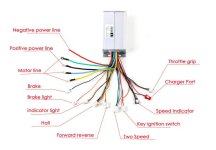Just_Ed
10 kW
Good info...I'm learning. keep it coming folks.
I always thought the axle would be split. Therefore, if two motors were used, as you suggest, I'm thinking each would have their own jackshaft (to change gear speed).
Another thought that comes to mind is during turns, would the frictional force from the tires/ground, cause one of the motors to be stressed in some manner? I think I figured this one out, but feel free to answer it anyway....you know, just in case.
Thinking 'Out-Of-The-Box'
On the subject of a single controller. Another ...What If ....Two motors,(brushed or brushless), (two controllers, connected together electrically), then connecting to a single point, i.e, the throttle. Wouldn't each motor feel better and react correctly, if the single signal, (from the throttle), is split to each of the controllers? Wouldn't each motor react, as if there was just one signal. Also some of the other accessories, could run off of one controller, or some off one controller, and some off the other.
Good thought. I'll look into the pedicab reference.
So if I plan/build a 48 volt system, I could use it with, lets say 36 or 24 volt of battery power. Net loss would be maybe, less speed or less longevity/distance.
Just to let you know, all this incoming information, is really really helpful.
Thank you to all contributors.
fechter said:Using two of the 1800w motor is not a bad idea. If you can figure out a way to independently gear each rear wheel, the dual motor setup can work like a differential to allow easier turning. With brushed motors, you can easily use two with a single controller.
I always thought the axle would be split. Therefore, if two motors were used, as you suggest, I'm thinking each would have their own jackshaft (to change gear speed).
Another thought that comes to mind is during turns, would the frictional force from the tires/ground, cause one of the motors to be stressed in some manner? I think I figured this one out, but feel free to answer it anyway....you know, just in case.
Thinking 'Out-Of-The-Box'
On the subject of a single controller. Another ...What If ....Two motors,(brushed or brushless), (two controllers, connected together electrically), then connecting to a single point, i.e, the throttle. Wouldn't each motor feel better and react correctly, if the single signal, (from the throttle), is split to each of the controllers? Wouldn't each motor react, as if there was just one signal. Also some of the other accessories, could run off of one controller, or some off one controller, and some off the other.
With a jack shaft or large ratio single reduction, you should be able to gear down enough to make the motors happy. You could even possibly have more than one gear using a derailleur or internally geared hub. I've seen some pedicabs that are close to your project so you may want to look at various pedicab designs. Most have a differential but with dual motors you could avoid the need for one.
Good thought. I'll look into the pedicab reference.
If you can accept relatively short range, you can keep the battery size fairly small. I would be looking at used Nissan Leaf batteries for something like that. If you find the range is too short later, you can always add more batteries.
So if I plan/build a 48 volt system, I could use it with, lets say 36 or 24 volt of battery power. Net loss would be maybe, less speed or less longevity/distance.
Just to let you know, all this incoming information, is really really helpful.
Thank you to all contributors.




